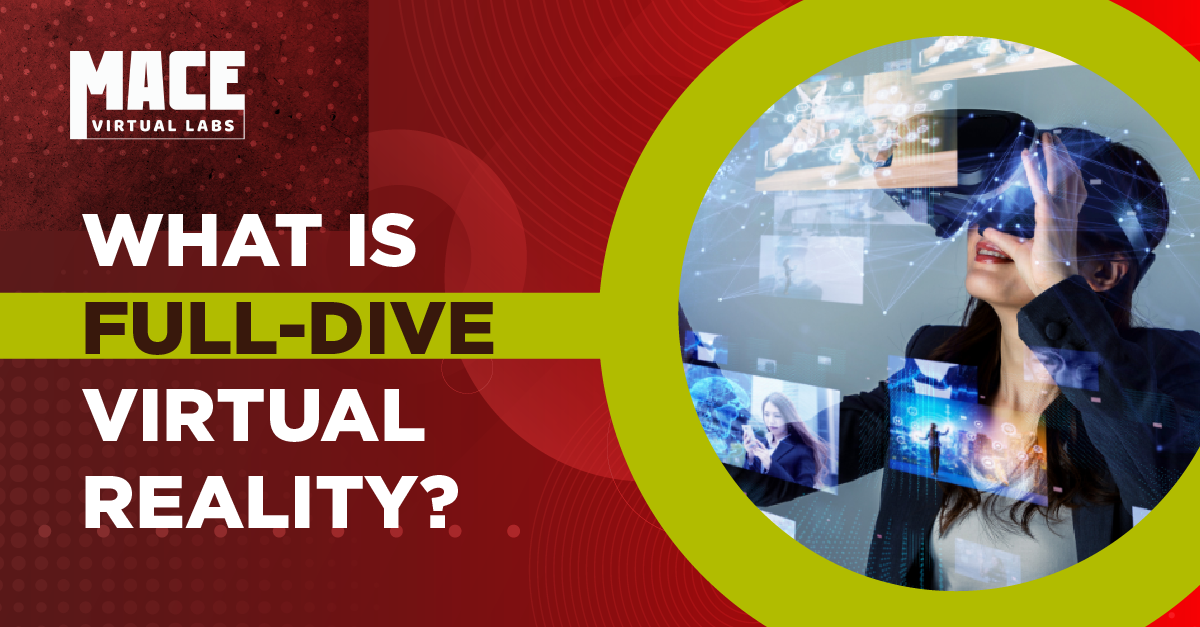What is Full-Dive Virtual Reality?
Extended reality (XR) technology has come a long way since users first put their phones inside cardboard boxes and held them up to their faces. Today’s VR headsets deliver stunning digital environments and intuitive motion controls, but that doesn’t mean technological advancements in the XR field are slowing down. One of the most intriguing recent XR developments is known as full-dive virtual reality.
If you’re unfamiliar with this new form of VR and what it has to offer, you’re not alone—but the team at MACE Virtual Labs can help. Keep reading for the complete guide to full-dive virtual reality and how this tech is already being put to use in the real world.
What is Full-Dive Virtual Reality?
In the XR world, it’s surprisingly common for fictional terms to be repurposed as the names of real technological advancements. Even today’s hottest VR-related buzzword, the “metaverse,” was introduced in the 1992 book Snow Crash. That’s also the case for “full-dive virtual reality,” a phrase that originated in the 2009 light novel Sword Art Online.
But full-dive VR doesn’t just sound like something out of science fiction. This technology builds on the visual and auditory experience delivered by “normal” VR headsets by adding equipment related to touch and locomotion to the mix. While full-dive VR is undoubtedly more complicated (and expensive) than traditional VR, you can’t beat the level of immersion it delivers.
To offer true full-dive VR, you’ll need:
VR headsets. No matter how advanced your XR strategy is, headsets are still the foundation of any virtual reality experience. In full-dive VR, these headsets work in concert with other pieces of equipment.
Haptic Suits. These bodysuits allow for full-body motion capture and can sense 84 different biometric signals, but their functionality doesn’t stop there. They can also deliver realistic haptic feedback and even simulated heat.
Hand-tracking hardware and software. To complete your motion-tracking capabilities, combining the data collected by your Teslasuits with solid hand-tracking software is crucial. That way, your users will be able to hold and manipulate virtual objects as easily as they handle items in the real world.
360-degree treadmills. The final piece of the full-dive virtual reality puzzle, 360-degree treadmills are an elegant solution to the challenge of movement in VR. When people walk on one of these treadmills, they’ll be able to get around the virtual world with zero risk of bumping into physical walls.
How Does it Enhance Training and Simulation Initiatives?
By now, you should understand full-dive virtual reality on a basic level. Still, you might be wondering about the concrete benefits of this cutting-edge technology—especially when it comes to training and immersive learning for high-consequence environments or scenarios.
When you invest in a full-dive VR setup, you’ll be able to take advantage of:
Full immersion. The key reason why VR training is so much more effective than standard training initiatives is the level of immersion it provides. And while traditional VR can control what users see and hear, full-dive VR goes one step further by controlling what they feel.
More accurate recreations of real-world situations. Since full-dive VR offers next-level immersion, it’s the best way to take trainees through a “dress rehearsal” of their job duties without leaving the office.
Quick, safe training. Like any other form of VR training, full-dive VR allows new employees to go through any scenario imaginable without putting themselves or others at risk of bodily harm.
Is Full-Dive Right for You?
It’s hard to deny that the technology behind full-dive VR is impressive—but it’s equally hard to deny the expenses involved. Because of that, full-dive virtual reality isn’t the best fit for every enterprise use case. Still, this tech can make a real difference, especially when you use it to train people who will regularly be involved in crisis situations.
To name just one example, any VR system can let new firefighters look around a burning building and hear the crackling flames around them. But only full-dive VR can convey the sense of heat created by those flames, further reducing the gap between your training simulator and the real experience it’s simulating.
When lives are on the line, anything you can do to enhance your training experience matters, so full-dive VR may be just what you need.
Dive into the Future
It’s easy to assume that full-dive virtual reality is still years or even decades away; however, that’s not the case. Even today, full-dive VR is a concrete reality—and MACE Virtual Labs is at the forefront of this new technology.
In November 2022, MACE VL announced a partnership with IOPEX LLC, Touro University California, and Shiny Box Interactive. This collaboration aims to create an integrated hardware and software platform focusing on full-dive VR. The partnership has allowed MACE VL to combine its XR hardware expertise with Shiny Box Interactive’s metaverse development knowledge. Meanwhile, Touro University California and IOPEX LLC are contributing their skills in creating simulators for military and civilian first responders.
Full-dive VR technology may not be as widely-used as traditional XR at this point, but that just means your organization has an opportunity to be a leader in this field. If you’re looking for a next-level training solution, MACE VL can help. Get in touch with one of our XR experts today!

